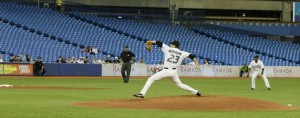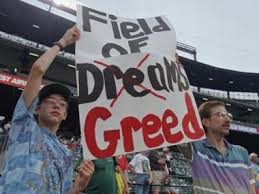20 Years Ago: Baseball’s Darkest Chapter
It is hard to believe that 20 years have now passed since money and greed in sports reached a startling climax with what ultimately became the cancellation of the final two months and postseason of the 1994 Major League Baseball season.
In the coming months retiring baseball commissioner Bud Selig will receive many accolades for all he has done to support the resurgence of the game of baseball, but as acting commissioner in 1994 he oversaw the destruction of the game and while it may have recovered financially and in overall popularity, in certain pockets, things have never been the same.
On August 12, 1994 the team with the best record in baseball was the Montreal Expos with a mark of 74-40. Now if you are under the age of 25, you may not even remember that there was ever a baseball team in Montreal and for that you can thank Selig and the others who failed to save the 1994 campaign.
The Expos, who had entered the league in 1969 and went an entire decade before posting a winning season, had developed into a solid franchise having posted .500 or better records 12 times since 1979. However, ironically, their only previous postseason appearance had come during the strike shortened 1981 campaign when they lost the National League Championship Series in five games to the Los Angeles Dodgers.
It was very clear that after all the close calls in previous seasons, 1994 was going to be the year for the Expos. Despite losing to the Pittsburgh Pirates 4-0 on August 11th to end a six game winning streak, the Expos were six games ahead of the Atlanta Braves and clearly looked positioned to capture their first-ever division crown and potentially reach the World Series for the first time.
With a young nucleus that included future stars Larry Walker, Pedro Martinez, Marquis Grissom, Rondell White and Moises Alou along with several other solid major leaguers, the Expos were clearly poised for success.
It was also clear that the city of Montreal was excited and supportive of their 1994 team. Some historians will say that Montreal never really supported the Expos and that a move was inevitable. Others will tell you that the fan base in Montreal during that time was quite solid and had they been able to experience World Series joy, as had happened in Toronto in the previous two seasons, the Expos would have eventually received a new stadium and would still be there today.
It is hard to predict “what might have been”, but one thing is clear, in the weeks prior to the baseball shutdown fans in Montreal were becoming extremely excited about the prospects for their team.
Though the Expos ranked 11th of 14 teams in the National League in overall attendance at the time of the strike, that total was a little deceiving as the Expos had played only 52 home games (compared to 62 on the road) and had been averaging an extremely respectable crowd of more than 24,000 fans per game. In fact, they had drawn more than 30,000 fans (including more than 39,000 for the final game) per night for a four game mid-week (Monday-Thursday) series against the St. Louis Cardinals from August 1-4.
With 30 home games remaining as they drove toward a possible pennant, it is likely that the Expos would have continued to draw large crowds through the remainder of the 1994 season.
Of course, we will never know, as both the baseball players and owners dug in and ultimately the two sides would not settle their differences until the remainder of the 1994 season was gone and the start of the 1995 season was delayed. The end result was a 232 day work stoppage and the cancellation of more than 900 games, including the playoffs and World Series for the first time since 1904.
While it is very easy to vilify Selig and the owners for their role in the strike and some of the aftermath, you also have to give much of the “credit” to Donald Fehr and the players.
To help create balance and reign in high spending, one of the proposals from the owners was for a payroll cap much like is now common in other professional sports. The owners claimed (likely accurately given what has happened in other sports) that creating a team payroll cap would increase average salaries from $1.2 million in 1994 to $2.6 million by 2001.
However, Fehr and the players refused the idea as they felt that a cap would give the players no benefit and was just trying to get the players involved in cleaning up the owners own issues related to over-spending by some teams.
As it turns out, the final system did not include a payroll cap, though there is now in place a form of luxury tax that only slightly deters the big payroll teams from over-spending.

Moises Alou and the Montreal Expos had the best record in baseball at the time of the 1994 strike, but never had a chance to bring home a championship to Montreal.
Though they had the second lowest payroll in the league, as a result of losses incurred during the strike the Expos ended up trading their four highest salary players before the start of the 1995 season. They finished 66-78 in 1995 and while they won 88 games in 1996, the fans never returned.
By the time the team was bought by the league in 2001 and moved to Washington following the 2004 season they were only a shell of what they had been in 1994 and played to minimal crowds at aging Olympic Stadium.
It is easy to point to the Expos as the greatest loser in the aftermath of the strike and labor agreement that followed, but there were others.
Between 1950 and 1994, only four teams (1953-1962 Chicago Cubs, 1953-1967 Kansas City Athletics, 1969-78 Montreal Expos and the 1977-1990 Seattle Mariners) registered periods of 10 or more consecutive losing seasons and two of those four were expansion teams.
Since 1994, five franchises (1993-2012 Pittsburgh Pirates, 1993-2004 Milwaukee Brewers, 1994-2005 Detroit Tigers, 1998-2007 Tampa Bay Rays and the 1998-2011 Baltimore Orioles) have registered stretches of 10 or more consecutive seasons with a losing record and only the Rays were an expansion team.
In addition, the Kansas City Royals had a losing record in 17 of 18 seasons between 1995 and 2012 (winning mark in 2004 interrupted their streak), the Cincinnati Reds had a streak of nine consecutive losing seasons from 2001-2009 and the Colorado Rockies have had only four winning seasons since 1997.
Another aftermath of the strike was the dwindling fan base in some cities that previously were among the strongest in the game.

The Toronto Blue Jays led the American League in attendance in 1994, but today tends to have a lot more empty seats than fans.
In 1994 the Toronto Blue Jays led the league with an average attendance of more than 49,000 fans per game. The Baltimore Orioles ranked second with more than 46,000 per game.
As both teams suffered through the 2000s, their fans disappeared in droves. The low-point was in 2010 when the Blue Jays averaged only 19,000 fans per game and the Orioles were only slightly better at 21,000.
Even this season as the two teams contend for a playoff berth, they have struggled to regain the support of what were once among the best fan bases in baseball. This season the Orioles are sixth in the American League with slightly more than 30,000 fans per game and the Blue Jays are seventh at 29,000 per contest.
While baseball has now gone 20 years with labor peace and is arguably much better financially than it was two decades ago, the legacy of the longest strike in league history also includes some brutal carnage and at least one city where they are left to wonder what might have been.

Heya are using WordPress for your blog platform? I’m
new to the blog world but I’m trying to get started and set up my own. Do you require any
html coding expertise to make your own blog?
Any help would be greatly appreciated!
Great post Dean – I remember 1994 very well. It really is a shame that the two sides couldn't come up with an agreement – I truly believe that the Montreal Expos would have gone on to win the National League East division title and I'm an Atlanta Braves fan. The Expo's were a very solid team loaded with talent and, in my opinion, headed for the '94 postseason and a possible World Series title. Unfortunately and very sadly we will never know…
Hi to every body, it’s my first pay a quick visit of this weblog; this
weblog consists of remarkable and really good stuff in favor of readers.
Take a look at my homepage – tefal vitacuisine compact
Baseball game had got a great history and only the true lover of this game would be interested to know it. I am pretty sure that it is a good idea to give time to play this game in spare time.
ティファールを二重にして知りたい。色々引き起こすと思います。ティファール似付かわしいのところは?業績です。